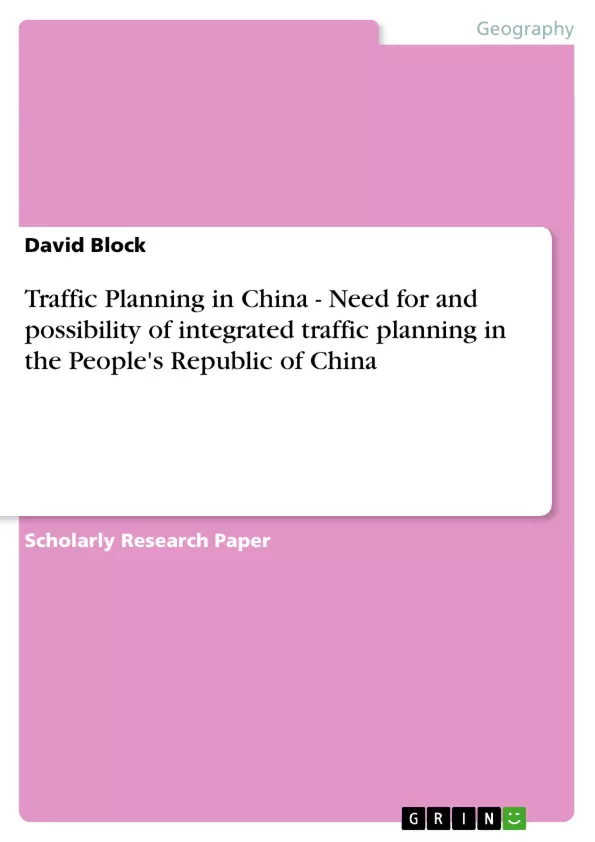Due to the constantly high rate at which the economy of the People’s Republic of China (PRC) is developing, the demand for transportation of passengers as well as goods is not only rapidly growing but also changing in nature. To cope with the growing and changing demand for transport the PRC’s authorities in charge of traffic planning have to come up with new ideas. The current strategy of isolated action for every mode of transportation will, as I show later, not be sufficient to keep up with the constant growth of the demand. This is further strengthened by the fact that a large part of the measures taken by the authorities are merely trying to catch up with changed demand. At the current level of traffic development and with the current growth rates this strategy will not be expedient in the future. To understand the changing demand for transportation it is necessary to know and understand the reasons for the change. I will therefore try to give a very short overview of the relevant historical developments and economic, demographic and political changes. Based on this knowledge I will attempt to draw a picture of the current state of the traffic system and traffic planning structures in the PRC and possible development scenarios. This will provide the background necessary to evaluate the state and possibilities of integrated traffic planning in the PRC.
Inhaltsverzeichnis (Table of Contents)
- 1 Introduction
- 2 Historic Development
- 2.1 Before 1979
- 2.2 Deng's Reforms
- 3 Economic, Demographic and Political Changes
- 3.1 Rapidly Growing Economy
- 3.2 Changing Demographics
- 3.3 Political Decisions Affecting Transport Needs
- 4 Current State of the Traffic System
- 4.1 Increase in Motorization
- 4.2 Personal Car Focus
- 4.3 Costs of Motorization
- 5 Current State of the Traffic Planning
- 5.1 General Power Structure
- 5.2 Power Structure in Traffic Planning
- 6 Implications for Integrated Traffic Planning
- 6.1 Possibilities for integrated traffic planning
- 6.2 Need for integrated traffic planning
- References
Zielsetzung und Themenschwerpunkte (Objectives and Key Themes)
This paper examines the growing demand for transportation in China, particularly in light of the country's rapid economic development. The author analyzes the historical factors, economic trends, and political decisions shaping transportation needs in the People's Republic of China. The paper delves into the current state of the traffic system and planning structures, highlighting the challenges posed by increasing motorization and the limitations of current planning strategies.
- The impact of China's economic growth on transportation demand
- The evolution of traffic planning in China, from historical context to current challenges
- The shift towards private car ownership and its consequences for the traffic system
- The need for integrated traffic planning to address the growing and changing transportation needs
- Potential strategies and solutions for effective and sustainable traffic management in China
Zusammenfassung der Kapitel (Chapter Summaries)
The first chapter provides an introduction to the paper's focus on the growing transportation demand in China. It highlights the need for new approaches to traffic planning in light of the rapid economic development and the limitations of the current isolated action strategy.
The second chapter reviews the historical development of transportation in China, examining the period before 1979 and the impact of Deng Xiaoping's reforms. This chapter emphasizes the influence of ideological and military needs on transportation decisions, highlighting the fragmentation of the economy before Deng's Open Door Policy.
The third chapter analyzes the economic, demographic, and political changes that are driving the transportation demand in China. It examines the rapid economic growth, changing demographics, and political decisions that have impacted transport needs.
The fourth chapter explores the current state of the traffic system in China, focusing on the increase in motorization, the shift towards personal car ownership, and the associated costs. This chapter highlights the challenges posed by the current traffic system and the need for innovative solutions.
The fifth chapter investigates the current state of traffic planning in China, examining the power structures and decision-making processes. This chapter discusses the limitations of the current planning approach and the need for a more integrated and comprehensive framework.
Schlüsselwörter (Keywords)
This work explores the complexities of traffic planning in China, focusing on the interconnectedness of economic growth, population shifts, political decisions, and the evolution of transportation systems. Key themes include the impact of Deng Xiaoping's reforms, the rise of private car ownership, and the need for integrated traffic planning to manage the growing and evolving demand for transportation.
- Quote paper
- David Block (Author), 2007, Traffic Planning in China - Need for and possibility of integrated traffic planning in the People's Republic of China, Munich, GRIN Verlag, https://www.grin.com/document/67792



